On the Historic Banks of the Cooper River, tucked between Shem Creek and the USS Yorktown, lies a spirited oasis known as Charleston Harbor Marina. With 459 slips ranging in size from 33 to 66 feet, as well as Boat Lifts to 25 feet elevated, Charleston Harbor Marina stands as the largest in water marina in the state of South Carolina. The premier facility is home port to the finest yachtsmen in the Carolina’s, and with over 17,000 lineal feet of floating dock, is able to accommodate a large range of vessels to120 feet.
Whether sailing in the harbor, or just watching the wide array of Nature from the docks, there is beauty in every moment. |
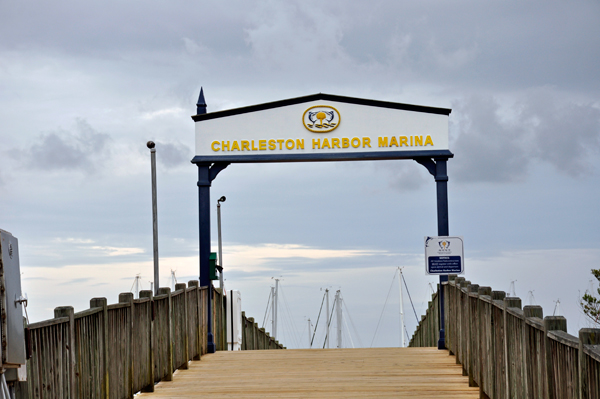
|
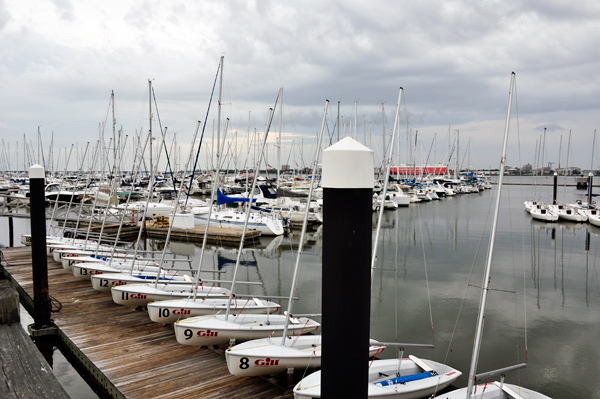
|
 Below: USS Laffey (DD-724) was an Allen M. Sumner-class destroyer of World War II, laid down and launched in 1943, and commissioned in February 1944. The ship earned the nickname "The Ship That Would Not Die" for her exploits during the D-Day invasion and the battle of Okinawa when she successfully withstood a determined assault by conventional bombers and the most unrelenting kamikaze air attacks in history. Laffey was the second ship of the United States Navy to be named for Bartlett Laffey. Seaman Laffey was awarded the Medal of Honor for his stand against Confederate forces on 5 March 1864. Below: USS Laffey (DD-724) was an Allen M. Sumner-class destroyer of World War II, laid down and launched in 1943, and commissioned in February 1944. The ship earned the nickname "The Ship That Would Not Die" for her exploits during the D-Day invasion and the battle of Okinawa when she successfully withstood a determined assault by conventional bombers and the most unrelenting kamikaze air attacks in history. Laffey was the second ship of the United States Navy to be named for Bartlett Laffey. Seaman Laffey was awarded the Medal of Honor for his stand against Confederate forces on 5 March 1864.
Today, Laffey is a U.S. National Historic Landmark and is preserved as a museum ship at Patriots Point, outside Charleston, South Carolina, alongside two other US National Historic Landmarks: the aircraft carrier Yorktown and submarine Clamagore.
In October 2008, it was discovered that over 100 leaks had sprung up in Laffey's hull, and officials at Patriots Point were afraid that the ship would sink at her mooring. An estimated $9 million was needed to tow the ship to dry dock for repairs, prompting Patriots Point officials to secure a $9.2 million loan from the state of South Carolina to cover the costs.
On 19 August 2009, she was towed to Detyens Shipyards in North Charleston on the Cooper River for repair in dry dock. The rust-eaten, corroded hull was repaired with thicker plating, miles of welding, and new paint.
On 16 April 2010, the Board of Trustees of Clemson University reached a lease agreement for Patriots Point organization to moor Laffey adjacent to Clemson's property at the former Naval Base Charleston in North Charleston.
Laffey was returned to Patriots Point on 25 January 2012 with more than a dozen former crew members among the crowd on hand to greet her. Said one veteran, "This means a lot of years of fighting to get her saved again. The Germans tried to sink her. The Japanese tried to sink her and then she tried to sink herself sitting here. She's whipped them all and she's back again."It cost $1.1 million to return the ship and to make repairs to accommodate her in a new berth at the front of the museum. |
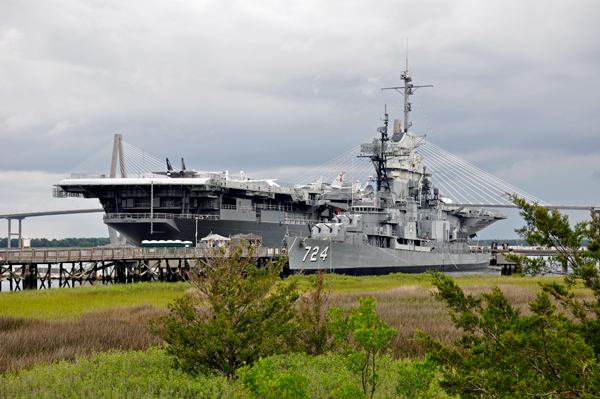
|
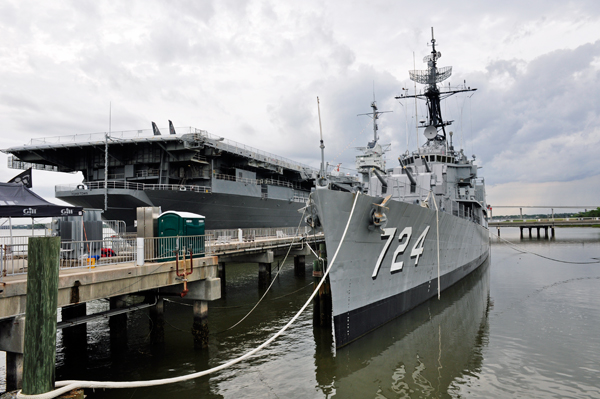
|
 USS Yorktown (CV/CVA/CVS-10) is one of 24 Essex-class aircraft carriers built during World War II for the United States Navy. She is named after the Battle of Yorktown of the American Revolutionary War, and is the fourth U.S. Navy ship to bear the name. Initially to have been named Bonhomme Richard, she was renamed Yorktown while under construction to commemorate USS Yorktown (CV-5), lost at the Battle of Midway in June 1942. Yorktown was commissioned in April 1943, and participated in several campaigns in the Pacific Theater of Operations, earning 11 battle stars and the Presidential Unit Citation. USS Yorktown (CV/CVA/CVS-10) is one of 24 Essex-class aircraft carriers built during World War II for the United States Navy. She is named after the Battle of Yorktown of the American Revolutionary War, and is the fourth U.S. Navy ship to bear the name. Initially to have been named Bonhomme Richard, she was renamed Yorktown while under construction to commemorate USS Yorktown (CV-5), lost at the Battle of Midway in June 1942. Yorktown was commissioned in April 1943, and participated in several campaigns in the Pacific Theater of Operations, earning 11 battle stars and the Presidential Unit Citation.
Decommissioned shortly after the end of the war, she was modernized and recommissioned in the early 1950s as an attack carrier (CVA), and then eventually became an antisubmarine carrier (CVS). She was recommissioned too late to participate in the Korean War but served for many years in the Pacific, including duty in the Vietnam War, in which she earned five battle stars. Late in her career, she served as a recovery ship for the Apollo 8 space mission, and was used in the movie Tora! Tora! Tora! which recreated the Japanese attack on Pearl Harbor; and in the science fiction film The Philadelphia Experiment.
Yorktown was decommissioned in 1970 and in 1975 became a museum ship at Patriots Point, Mount Pleasant, South Carolina. She was declared a National Historic Landmark in 1986. |
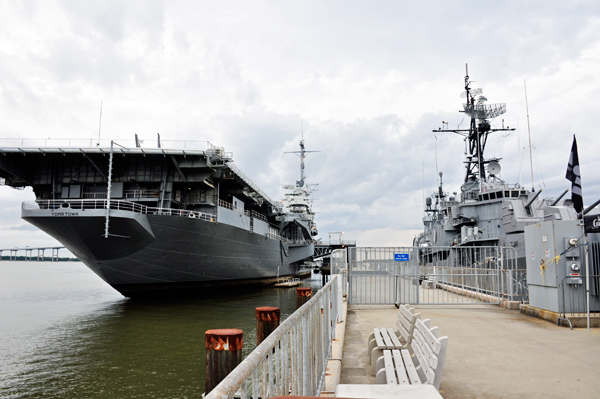
|
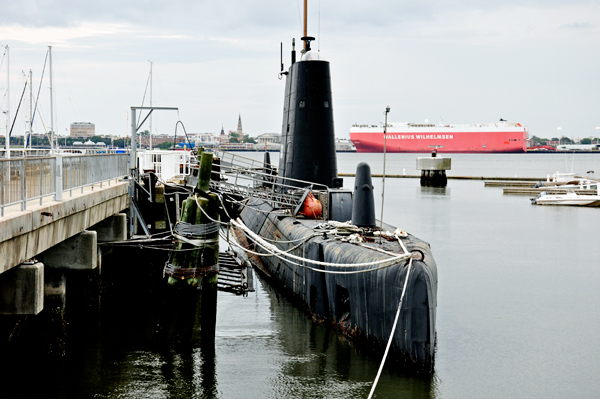
|
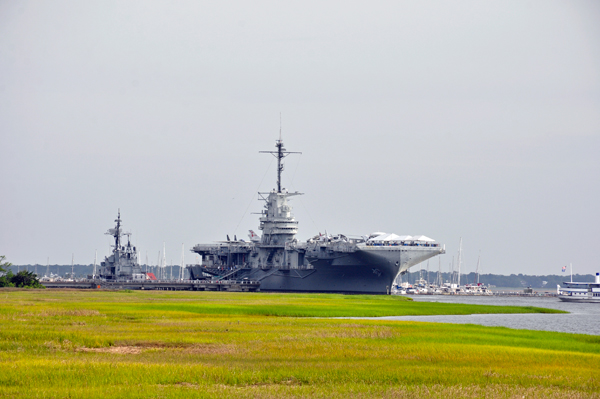
|
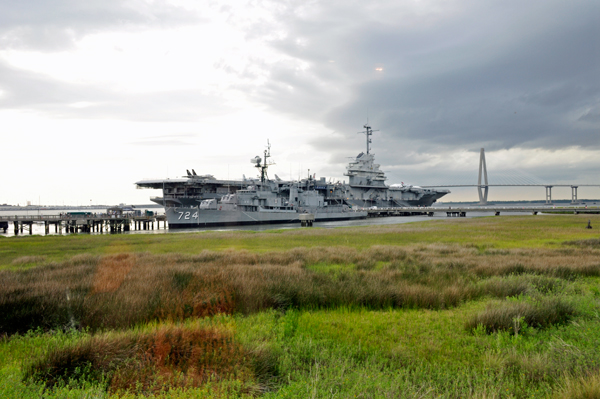
|
The above quotes are from https://en.wikipedia.org/ |


 Below: USS Laffey (DD-724) was an Allen M. Sumner-class destroyer of World War II, laid down and launched in 1943, and commissioned in February 1944. The ship earned the nickname "The Ship That Would Not Die" for her exploits during the D-Day invasion and the battle of Okinawa when she successfully withstood a determined assault by conventional bombers and the most unrelenting kamikaze air attacks in history. Laffey was the second ship of the United States Navy to be named for Bartlett Laffey. Seaman Laffey was awarded the Medal of Honor for his stand against Confederate forces on 5 March 1864.
Below: USS Laffey (DD-724) was an Allen M. Sumner-class destroyer of World War II, laid down and launched in 1943, and commissioned in February 1944. The ship earned the nickname "The Ship That Would Not Die" for her exploits during the D-Day invasion and the battle of Okinawa when she successfully withstood a determined assault by conventional bombers and the most unrelenting kamikaze air attacks in history. Laffey was the second ship of the United States Navy to be named for Bartlett Laffey. Seaman Laffey was awarded the Medal of Honor for his stand against Confederate forces on 5 March 1864.































